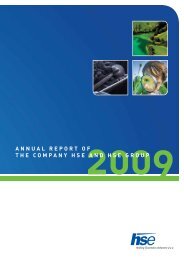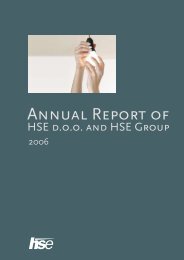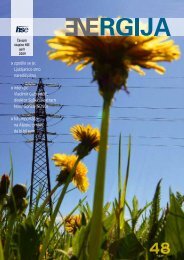Annual report - HSE
Annual report - HSE
Annual report - HSE
You also want an ePaper? Increase the reach of your titles
YUMPU automatically turns print PDFs into web optimized ePapers that Google loves.
2.6 Market position<br />
2.6.1 Features of the Slovenian economic environment<br />
Decrease in GDP<br />
In 2012, the real decrease in the Slovenian GDP amounted to 2.3%, mostly as a result of<br />
decreased domestic consumption at private, as well as at the national level.<br />
Investment continued to drop as well. Smaller domestic demand reflects also in<br />
international transactions; import of goods and services was lower by 6.6% compared with<br />
2011, while export remained unchanged.<br />
<strong>Annual</strong> inflation<br />
The year-on-year inflation in Slovenia amounted to 2.7% at the year-end, which exceeded<br />
the Eurozone average. Fluctuation of prices was caused predominantly by week economic<br />
activity, locally and globally. Higher year-on-year inflation was mostly a result of higher<br />
prices of food, services and energy products, but also of higher excise duties.<br />
Credit crunch<br />
Decreased lending to the domestic non-banking sector intensified at the end of the year,<br />
while net repayment of the Slovenian banks’ liabilities to international organisations<br />
continued.<br />
Electricity consumption<br />
General consumption of electricity in 2012 decreased by 1% compared to the previous<br />
period.<br />
Decrease in economically active population<br />
The unemployment rate increased once again. The average number of unemployed in<br />
2012 was 90,000, which is 6000 more than in 2011.<br />
2.6.2 Market environment of the electricity industry<br />
In 2012, the European economy faced escalation of the its debt crisis, which reached the<br />
peak in the summer when the required rate of return on 10-year Spanish and Italian bonds<br />
amounted to 7.7% and 6.6%, respectively. After the speech of the ECB president Mario<br />
Draghi on 26 July 2012, when he made a commitment that the ECB will do ‘whatever it<br />
takes to preserve the euro’, the situation on financial markets calmed down and the<br />
pressure regarding the value of bonds issued by problematic countries slightly decreased<br />
by the end of the year. Due to great debt, measured according to GDP share, the Eurozone<br />
members bound to adopt strict general government saving measures. This resulted in<br />
reduced demand for final products and the Eurozone economy recorded a 0.9% GDP<br />
decrease, despite stable economic circumstances in the USA and China.<br />
All this affected the impaired euro currencies against American dollar, which on one hand<br />
improved the competitiveness of European exporters in the global market, while on the<br />
other hand it increased the prices of energy products within the EU quoted in American<br />
dollars. Decreased demand caused a significant drop in the Eurozone industrial production,<br />
which on annual basis amounted to -2.2%, resulting in reduced electricity consumption in<br />
2012.<br />
With regard to the transmission of electricity across Slovene borders, we should mention<br />
that the Slovene transmission network operator, ELES, in accordance with the European<br />
directive concerning the allocation of cross-border transmission capacities, continued with<br />
market-based allocation of cross-border transmission capacities through explicit auctions.<br />
The allocation of daily cross-border transfer capabilities to Slovenian-Italian border was<br />
<strong>Annual</strong> Report <strong>HSE</strong> 2012<br />
2 Business Report<br />
53
















